Are you looking to spruce up your chameleon’s enclosure with plants? Read up on which plants are safe to house with your chameleon.
In this guide, you’ll learn:
- What are the benefits of having plants in your enclosure?
- What are chameleon safe plants to add?
- What plants should be avoided?
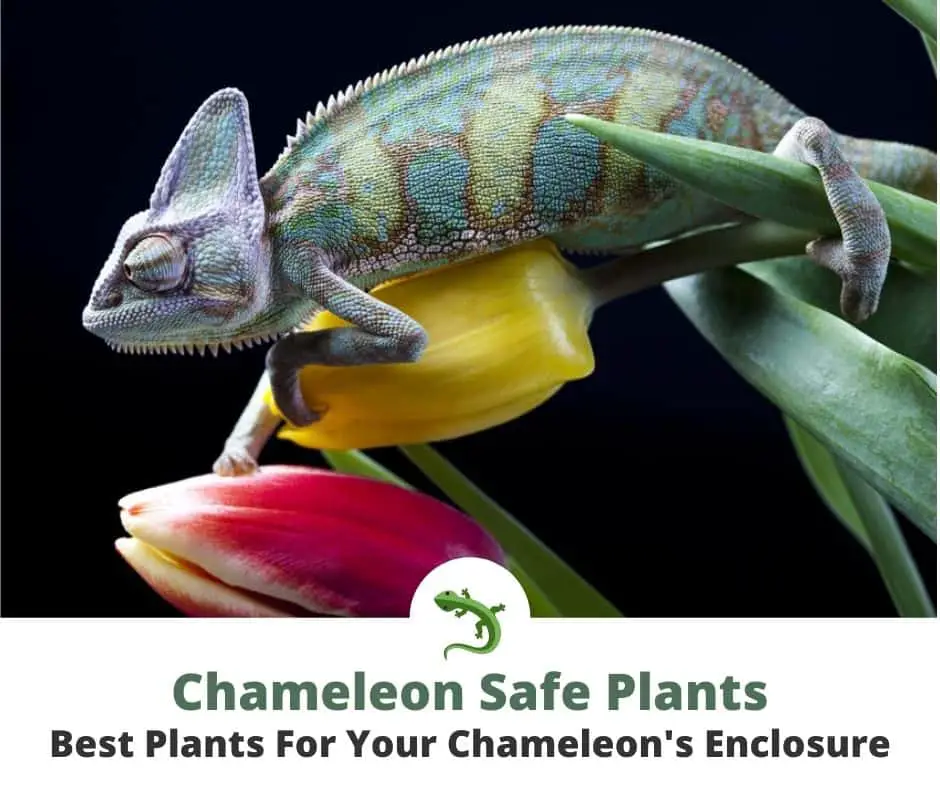
Chameleons are beautiful and interesting animals that require delicate care. Coming from the rainforest and deserts of Africa, chameleons spend their lives in the wild on trees, climbing and hiding in the leaves. A good vivarium for your chameleon should recreate the living conditions of these lizards in their natural habitat with the proper temperature, heat, lighting, and humidity levels. Humidity requirements for chameleons, in particular, are tied to the choice of plants.
Chameleons do not obtain water from drinking as other lizards do. Instead, they drink the water droplets that fall from leaves. They help keep the humidity in the tank whilst cleaning the air, creating a healthy and nature-like environment for your lizard. Plants also help create hiding places for your chameleon to feel safe in and since chameleons prefer to be left alone, this helps lower their stress levels.
This makes plants in your chameleon’s terrarium almost necessary and choosing safe ones is obviously a priority. This article will guide you through all the dos and don’ts of choosing the plants of your chameleon’s terrarium.
What To Do Before Adding ANY Plant To Your Chameleon’s Enclosure
Chameleons tend to chew the leaves that are available to them so it’s important to make the plants you intend to add are not toxic when eaten. Their skin can also be sensitive to common and seemingly harmless plants, like crotons.
Important
Anything you plan to add to your reptile’s terrarium should be thoroughly cleaned and disinfected. For plants, this makes sure there are no pesticides or other toxins that could harm your chameleon.
Are Artificial Plants Ok For Chameleons?
While it is not directly harmful to have artificial plants inside your chameleon’s enclosure, there are many more advantages to having live plants. Although some fake plants are a safe option because they don’t include toxic chemicals. You also don’t have to take care of them and they are sturdy enough for your chameleon to climb. Live plants will, however, maintain the humidity of your chameleon’s cage and help clean the air.
Obviously, your chameleon can’t eat plastic plants, refraining them from getting some supplementary nutrients to their insect-based diet. It is possible that even if they are made of plastic, the color and texture lead your chameleon into thinking they are real plants, which can lead to ingestion and other digestive issues.
While artificial plants are ok to use as an ornament, they can never replace the properties real plants give to your chameleon’s enclosure. It is highly advised that you use real plants in your lizard’s cage, as the benefits of doing so are more than the ones fake plants can provide.
Safe Plants For Chameleons
There are many choices of plants you can place in your chameleon’s enclosure. Go for woody and leafy plants for maximum climbing and hiding areas. Trailing vines and big leaves help with humidity and complete the look of a natural chameleon habitat. The best plants balance aesthetics, safety, and ease of care.
Yucca
With a tropical look and a resistant build, yucca is a great plant to include in your chameleon’s enclosure.
Native to the south of the United States and Central America, yuccas come from semi-desert areas. They endure high temperatures well and adapt quite well to different environments.
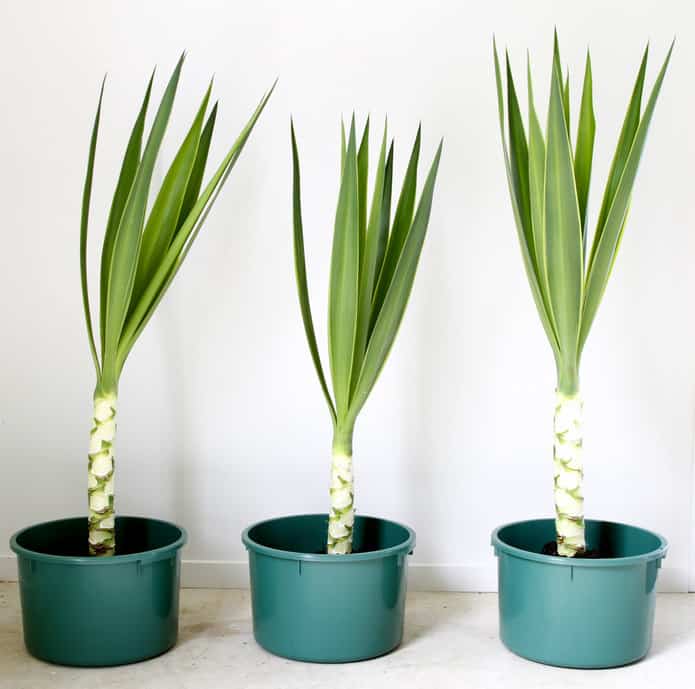
Benefits of yucca plants
Their thick foliage helps clean air and provides chameleons with many hiding spaces. They have tree-like trunks, allowing chameleons to climb on them easily compared to other plants.
Although it’s not their favorite pick since their leaves are very big, spiky, and thick, it is safe for chameleons to eat yucca and to drink the water drops formed on their leaves.
How To Take Care Of Yucca plants
Yucca plants are quite easy to take care of. They don’t require any specific soil other than it is well-draining to avoid root rot. However, replacing their original soil with organic soil will make it safer for your chameleon to be around the yucca plant.
Yuccas are quite adaptable; they are extremely drought resistant and you can cut them to the size that you need without fear of harming them. The only downside is that the growth of yucca plants can be quite unpredictable because as soon as you cut the trunk, the plant quickly develops another from the cut point.
The optimal lighting condition for yucca plants is partial shade. Allow them to enjoy some bright hours every day without keeping it directly in the sun. If your yucca turns yellow, it is probably receiving too much sun.
Weeping Figs
Ficus Benjamina, commonly known as weeping fig, is the best match for a chameleon’s terrarium. Weeping figs are one of the most common house-grown plants thanks to their strength and adaptability.
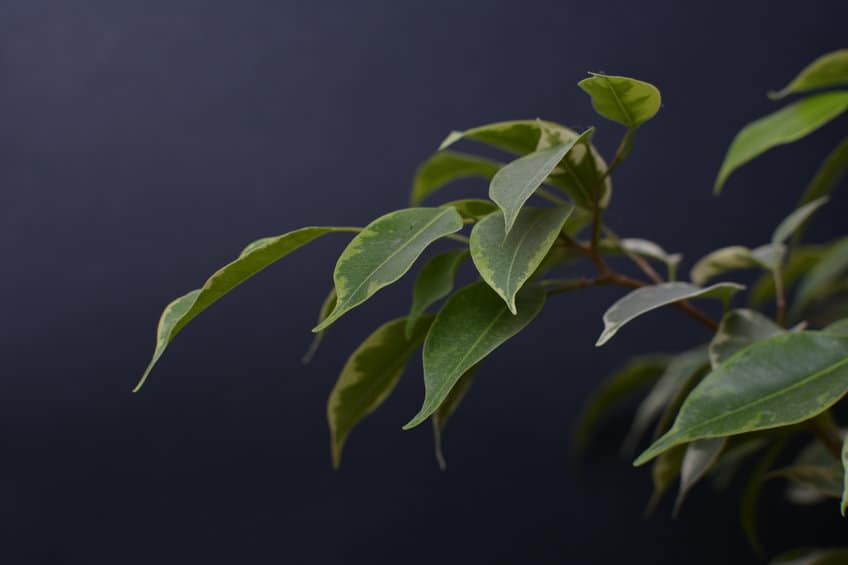
Benefits of Weeping Figs
Ficus Benjamina maintains their tree shape regardless of their size. They are quite strong, making them optimal for your chameleon to climb and hide in. Their leaves are not toxic for lizards and they resemble the natural habitat of chameleons.
How to take care of Weeping Figs
Taking care of weeping figs is fairly easy. They enjoy bright indirect or filtered light, so direct sun exposure is not recommended. If your ficus starts losing leaves, it is probably exposed to too much light and you should relocate it to a darker part of the terrarium.
However, ficus doesn’t really enjoy being moved around, so it is better to find a good placement for them from the start. Ficus trees are also quite sensitive to low temperatures, but so are your chameleons, so that shouldn’t cause any problems.
Ficus trees should never be kept in temperatures under 60°F, although they prefer environments above 70°F. They also need a humid environment, which is also perfect for your chameleon.
Rubber Trees
Much like the weeping fig, rubber trees also belong to the ficus family. Ficus elastica is the technical name for rubber plants, referring to the consistency of the leaves, which are big and extremely flexible. The abundant foliage and solid build of rubber trees make it a very good pick for your terrarium.
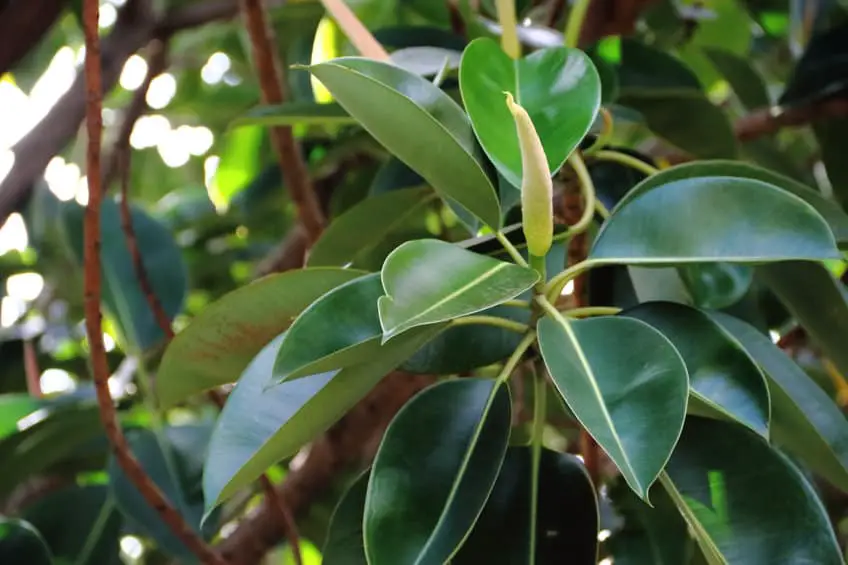
Benefits of Rubber Trees
They are quite strong and their big leaves and structure make them very easy to climb for your chameleon. They also make great hiding spots for the moments where your pet doesn’t want to be seen. Also, they don’t need a lot of special care and they adapt well to the living conditions of chameleons.
The downfall to rubber trees is that they can be mildly toxic for your chameleon if eaten too often. You should monitor how much of the plant your chameleon is eating to reduce the risk of intoxication.
How to take care of Rubber Trees
Like the Ficus Benjamina, the Ficus Elastica or rubber tree doesn’t enjoy direct sunlight. Instead, it prefers indirect or filtered light. Regarding water, rubber trees should live in humid environments. You can control whether your rubber tree is adapting correctly to the humidity levels of your vivarium by observing its leaves. If they are green and have a healthy look, there is nothing to worry about. On the contrary, if the leaves are turning yellow or falling, it means that the humidity levels are too high for your rubber tree.
Regarding size, rubber trees can get very big – since they are trees, so if you want to keep them in your lizard’s enclosure, you should cut them often to maintain their shape and size.
Dracaena compacta
The dracaena compacta is a beautiful tree-shaped plant. It is commonly known as the compact dragon tree. The name references how the leaves are distributed in the tree, in very compact groups that grow from the main trunk. With its dark green leaves and its exotic look, the dracaena compacta is a popular choice for chameleon enclosures.
Benefits of Dracaena compacta
Unlike the rubber tree and other plants from the ficus family, the dracaena compacta grow very slowly, so you don’t have to worry about cutting it.
How to take care of dracaena compacta
Dracaenas are a low-maintenance plant. They need indirect sunlight and are best placed in corner spaces. Compact dragon trees don’t need to be watered often (once every ten days should be enough), but they need some environmental humidity to keep healthy.
If you expose your plant to too much humidity it will lead to root rot, which you will notice if your plant starts taking a yellow coloration. On the other hand, if the environment is too dry for your plant, the tip of its leaves will dry out. If you notice the first symptoms of overwatering or drying out, you should act fast, because although Dracaenas are quite resistant, once they start showing problems, their health tends to deteriorate quite fast.
Golden pothos
Golden pothos is an incredibly popular plant to have at home, that is why they are known by very different names in different parts of the world.
One of the names it is known for is Devil’s ivy because it is so easy to take care of that it is almost impossible to kill. You can easily turn them into more than one plant by chopping off a part and planting it again to better fit your terrarium.
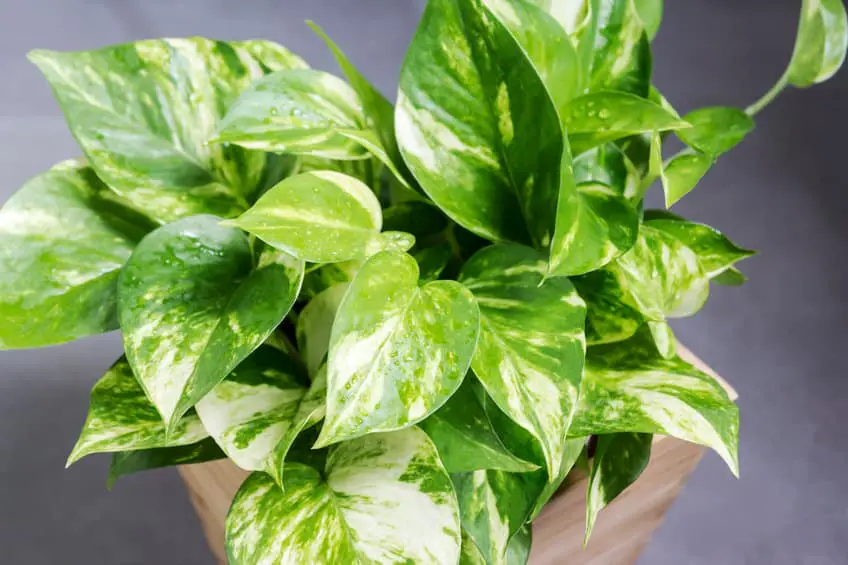
However, golden pothos does have a downside since they can be mildly toxic for your chameleon. This won’t be a problem unless your chameleon eats golden pothos leaves regularly, a case in which you should remove the plant from the cage. Intoxication by pothos is extremely rare for chameleons so you can still use this in their enclosure.
Benefits of Golden Pothos
The adaptability and beautiful foliage of Golden Pothos make it a perfect match for your chameleon’s cage. It’s also widely available and quite easy to grow and take care of.
How to take care of Golden Pothos?
As we said before, golden pothos is one of the most adaptable plants. They can handle almost any type of light and they will be a perfect fit for your vivarium. If you notice them having a bit of a languished appearance, you should just water them and they will easily recover their original state.
Golden pothos doesn’t have deep roots, so the soil should not be much of a problem either. You should make sure that the earth they are planted on has a good drainage system because root rot is one of the few things that can seriously harm them.
Hibiscus
Hibiscus plants are very common among lizard owners. They have beautiful and colorful flowers that give your terrarium a tropical look. On the downside, hibiscus plants are quite difficult to grow indoors, so even if they are a very good match for your animal, you should consider the effort of putting one in their cage. One exception to this rule is the Hibiscus rosa-sinensis– commonly called Chinese hibiscus- which is much easier to take care of than the rest of the plants from this family.
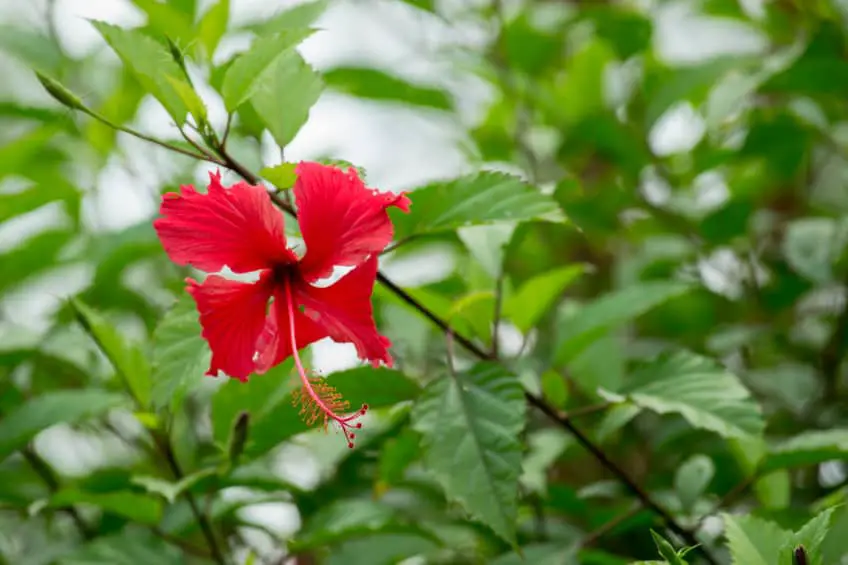
Benefits of Hibiscus
Hibiscus plants are not only captivating flowers but also a very nutritious meal supplement for your chameleon. The flowers are completely safe for them to eat and they contain a good amount of vitamin C, which is good to compensate for your chameleon’s insect-based diet. They also have quite solid bushes, providing good hiding and climbing spots for your pet.
How to take care of a hibiscus plant?
Growing a hibiscus plant indoors can be quite challenging. One of the main requirements for a healthy hibiscus plant is bright light. They ideally need natural light and lots of it. If you want to keep a hibiscus plant in your lizards’ enclosure, you should consider having more than one plant, so you can rotate them from the cage to another place with direct sunlight. This way you can always have one plant available for your chameleon to hide in.
To develop healthy flowers, they need a great number of nutrients. You should consider using a potassium fertilizer during the summer months to help the flowers maintain their beautiful appearance.
Although it might seem counterintuitive at first, hibiscus plants should also be cut once a year to help them grow healthier and stronger in the coming months.
Bromeliads
With a very peculiar appearance, bromeliads are a very good pick for your chameleon’s cage. Although bromeliads are well known for their distinctive flower, they only flower towards the end of their life. But whether they are young and green or blooming in their last months, bromeliads are quite easy to take care of and will give a lively look to your lizard’s tank.
Benefits of Bromeliads
Bromeliads are thick enough for your chameleon to hide in. They are also quite resistant, so they are a very safe option to include in your lizard’s tank. Their leaves are also strong enough to support your chameleon.
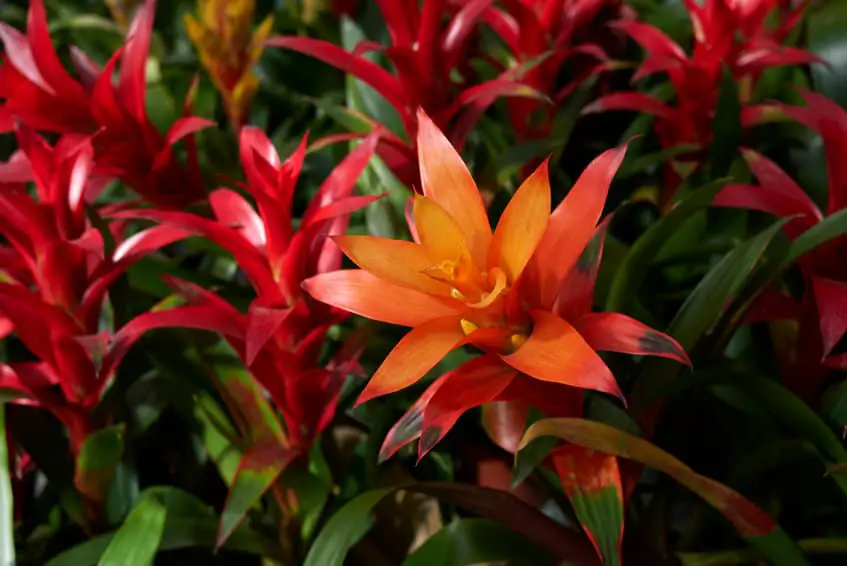
How to take care of Bromeliads
Bromeliads live best in warm and well-lit environments. They can adapt to a strong UVB light exposure, but it would be better for them to receive direct sunlight frequently. Despite their exuberant appearance, bromeliads don’t require a lot of special care. Much like chameleons, bromeliads need humidity to keep in good shape, so it is not difficult for them to adapt to your chameleons’ living conditions.
Which Plants Should Be Avoided For Chameleons?
Many plants can be a threat to your animals’ well-being, mostly through ingestion. Some of the most common plants that are toxic to chameleons are fig plants, crotons, and most types of philodendrons.
Fig plants
While some fig plants are safe for your chameleon to have around, there are some types of fig plants that should be avoided at all costs around your lizard. These are the Zulu fig, fiddle-leafed fig, and creeping figs. They can be toxic for your lizard and lead to poisoning.
Crotons
Crotons are a very popular house plant that can be deadly to chameleons. Its colorful big leaves look great in a vivarium, but they are extremely toxic when ingested. Croton is toxic to almost all animals, so it should not be a part of your chameleon’s environment
Philodendrons
Philodendrons have become an extremely popular plant to have indoors. Its showy appearance with beautifully shaped leaves and dense foliage looks perfect for a chameleon to hide in. Unfortunately, most philodendrons are very toxic. The sap the plant produces when its leaves break or cut can irritate the skin and mouth of your animal and even kill it if it ingests too much.
Conclusion
Chameleon safe plants are relatively easy to find and most are sturdy enough to survive the environment of a chameleon’s terrarium and dense enough to provide good hiding places. However, make sure that the plants you choose are non-toxic when ingested.
FAQs
Can chameleons eat fruit?
Yes. Although chameleons are mostly insectivores, some fruits can be optimal supplements for their diet. Fruits that have high calcium and low phosphorus content like apples, blueberries, peaches, melon, banana, and cantaloupe are okay for chameleons to eat. All citrus fruits should be avoided, as they are too bitter and can be harmful to your animal. When you feed fruits to a chameleon, you make sure you have removed all seeds. Also, grinding the fruit before you feed it to them will make it easier for them to eat.
Are hibiscus trees safe for chameleons?
Hibiscus trees are a great choice for lizards and chameleons are no exception. Hibiscus trees are non-toxic for your chameleon and they are an optimal pick to have in their cage.
Is a fiddle leaf fig good for chameleons?
Fiddle leaf figs are not a good diet option for your chameleon. They can irritate the delicate skin of chameleons and if eaten they can lead to the poisoning of your animal. Other types of fig plants you should avoid if you have a chameleon are zulu figs, creeping figs, and crotons.
What are the best live plants to put in a chameleon cage?
The best live plants to include in your chameleon’s enclosure, considering both looks and safety are golden photos, yuccas, rubber trees, hibiscus, Ficus benjamina, and Ficus elastica. Some other plants you can include are the Schefflera arboricola (also known as dwarf umbrella tree) and Split Leaf Philodendron.
These plants are safe for your chameleon to eat and drink from and provide good hiding and climbing spaces.
What plants can veiled chameleons eat?
Veiled chameleons and panther chameleons can safely consume pothos leaves, ficus, kale, romaine lettuce, and other dark, leafy greens. Chameleons remain insectivorous animals, but feeding them plants every once in a while is a great way to supplement their diet.
References
Short article on Plants and Reptiles:
Reptiles And Houseplants: Growing Plants For A Terrarium With Reptiles
Informative article on chameleon care:
Introduction to Chameleon Husbandry
Scientific article on the biology of chameleons:
(PDF) Biology of the chameleons: an introduction
Basics of Chameleon Care:
Quick facts:


